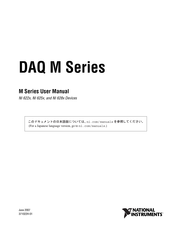User Manuals: National Instruments NI 6259 M DAQ Device
Manuals and User Guides for National Instruments NI 6259 M DAQ Device. We have 1 National Instruments NI 6259 M DAQ Device manual available for free PDF download: User Manual
National Instruments NI 6259 M User Manual (411 pages)
DAQ M Series
Brand: National Instruments
|
Category: Media Converter
|
Size: 7.7 MB
Table of Contents
Advertisement
